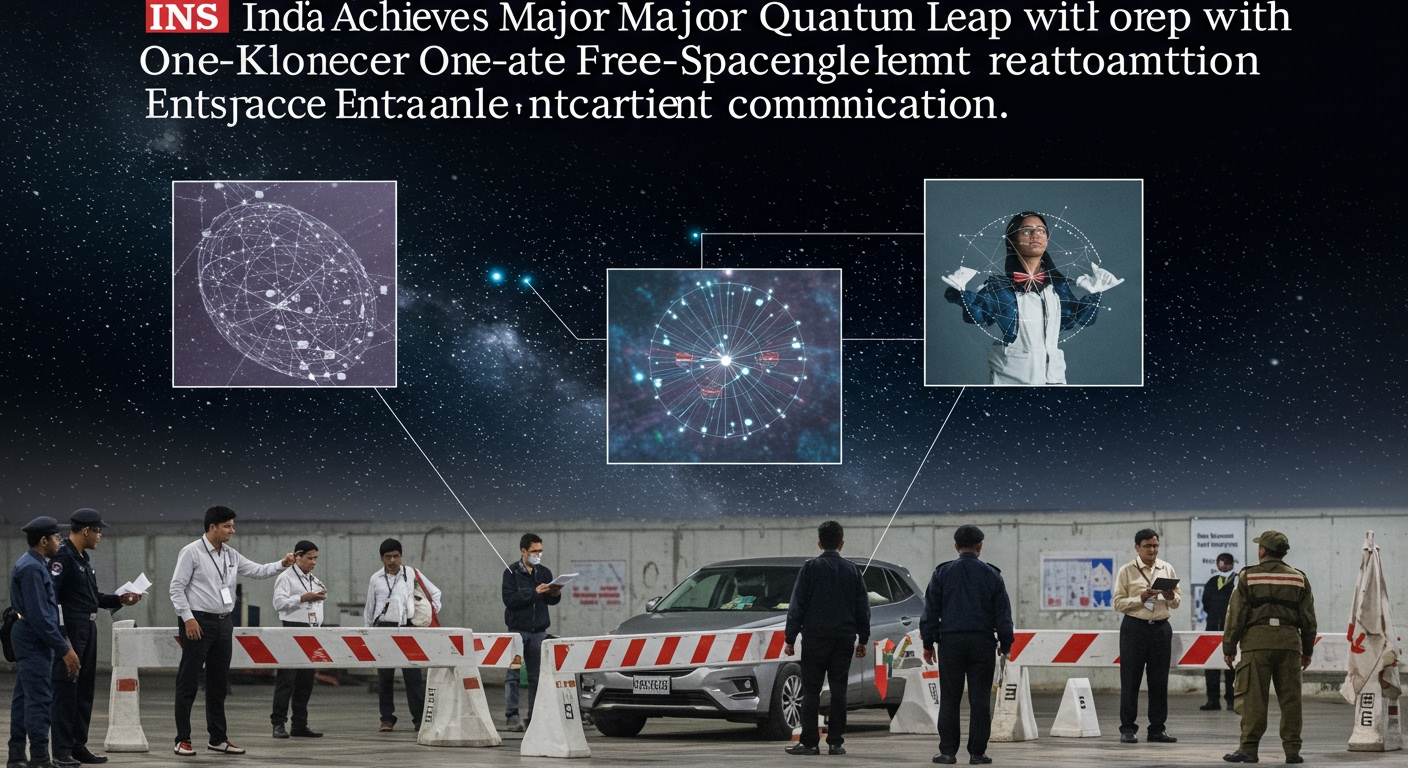New Delhi, India – India has marked a significant milestone in the burgeoning field of quantum technology with the successful demonstration of free-space quantum secure communication over a distance of one kilometer. This achievement, utilizing quantum entanglement, represents a critical step towards developing highly secure communication networks that operate independent of physical infrastructure like fiber-optic cables.
The experiment, conducted at the prestigious Indian Institute of Technology (IIT) Delhi, was a part of a project supported by the Defence Research and Development Organisation (DRDO). It specifically employed entanglement-based quantum key distribution (QKD), a method leveraging the peculiar properties of quantum mechanics to ensure the utmost security in data transmission.
Unpacking the Technology: Entanglement and QKD
At the heart of this breakthrough lies quantum entanglement. Often described as “spooky action at a distance,” entanglement is a quantum phenomenon where two or more particles become linked in such a way that they share the same fate, regardless of the physical distance separating them. Measuring a property of one entangled particle instantaneously influences the state of the other, even across vast distances. This intrinsic connection is harnessed in quantum communication.
Quantum key distribution (QKD) is a method for establishing a shared secret key between two parties (commonly referred to as Alice and Bob) in a way that is fundamentally secure due to the laws of quantum physics. Any attempt by an eavesdropper to intercept or measure the quantum particles carrying the key information inevitably disturbs their quantum state, alerting Alice and Bob to the presence of interference. Entanglement-based QKD, as used in the IIT Delhi experiment, generates pairs of entangled photons. One photon is sent to Alice and the other to Bob. By measuring their respective photons and comparing results based on the correlations inherent in entanglement, they can generate a secure, random encryption key.
The Significance of Free-Space Communication
Traditional long-distance quantum communication often relies on fiber-optic cables. While effective, these cables have limitations, particularly regarding photon loss over long distances and the need for infrastructure installation and maintenance. Free-space quantum communication, on the other hand, transmits quantum signals through the air or vacuum. This approach offers potential advantages for line-of-sight links, establishing connections rapidly in challenging terrains, or enabling communication with moving platforms like satellites or aircraft.
The successful demonstration over a one-kilometer link in free space by Indian researchers underscores the viability of this method for future applications, potentially extending secure quantum links where deploying or relying on fiber infrastructure is impractical or impossible.
Key Metrics of the Achievement
The technical details of the experiment highlight its success and potential. According to a statement released by the country’s Ministry of Defense, the test achieved a secure key rate of 240 bits per second. The secure key rate is a crucial metric, indicating the speed at which usable, secret key material can be generated between the two endpoints. A rate of 240 bits per second, while modest compared to classical communication speeds, is significant for an initial free-space quantum entanglement demonstration and is sufficient for various secure applications, such as encrypting sensitive data or establishing secure voice links.
Equally important is the quantum bit error rate (QBER), which measures the frequency of errors introduced during the transmission of quantum information. A low QBER is essential for extracting a reliable secret key and detecting potential eavesdropping. The experiment maintained a QBER below 7%, a figure well within the acceptable threshold for extracting a secure key using standard error correction and privacy amplification protocols.
Collaborative Effort and Strategic Implications
This achievement was the result of collaborative efforts spearheaded by the DRDO-Industry-Academia Centre, showcasing the synergy between research institutions, defence establishments, and potentially future industrial partners in India’s push towards quantum technological self-reliance. The project’s success validates theoretical models and experimental techniques developed domestically.
The Ministry of Defense statement explicitly highlights the strategic importance of this development. It emphasizes that this demonstration effectively eliminates the need for fiber-optic cables for long-distance secure communication, a point of particular relevance for military and strategic networks that might require secure links in diverse or rapidly changing environments. Furthermore, the Ministry affirmed that this breakthrough strongly supports national goals in defense, cybersecurity, and the establishment of future quantum networks.
For defense, quantum communication promises unbreakable encryption for sensitive military communications, intelligence sharing, and command and control systems. In cybersecurity, QKD can secure critical infrastructure, financial transactions, and government data against increasingly sophisticated classical and future quantum computing-based threats. Looking ahead, successful entanglement distribution over distance is a foundational requirement for building distributed quantum networks and eventually, a quantum internet, enabling applications far beyond secure communication, such as distributed quantum computing and enhanced sensing.
Paving the Way Forward
The successful one-kilometer free-space entanglement test at IIT Delhi represents more than just a laboratory achievement; it is a tangible demonstration of India’s growing capability in the complex and strategically vital field of quantum technology. While a one-kilometer link is a starting point, the principles and techniques validated by this experiment can be scaled and refined to achieve longer distances, potentially involving satellite-based systems for truly global quantum communication capabilities.
As nations race to develop quantum technologies, milestones like this position India as a serious player on the global stage. The integration of such advanced capabilities into national defense and cybersecurity infrastructure is paramount in an era where information security is synonymous with national security. This DRDO-supported initiative underscores India’s commitment to leveraging cutting-edge science for strategic advantage and building a robust, future-ready communication ecosystem.





